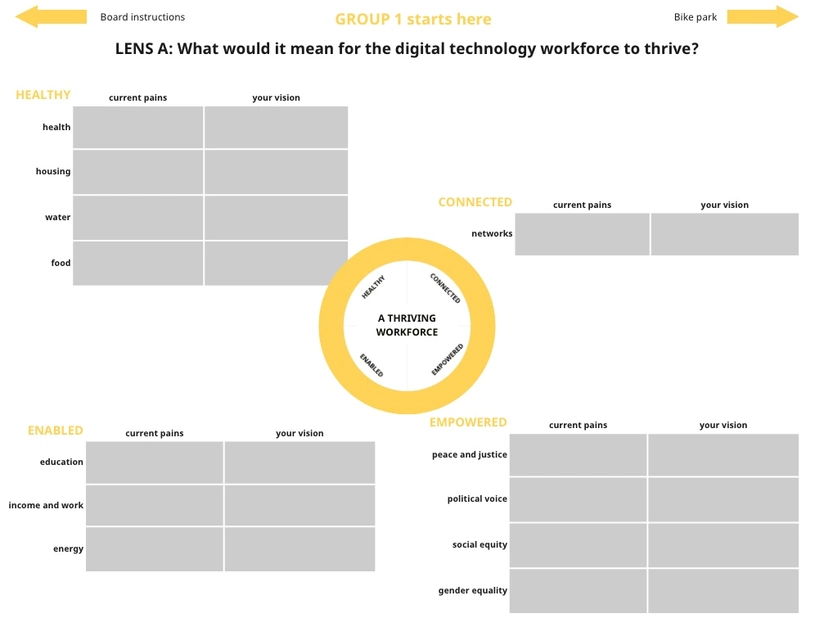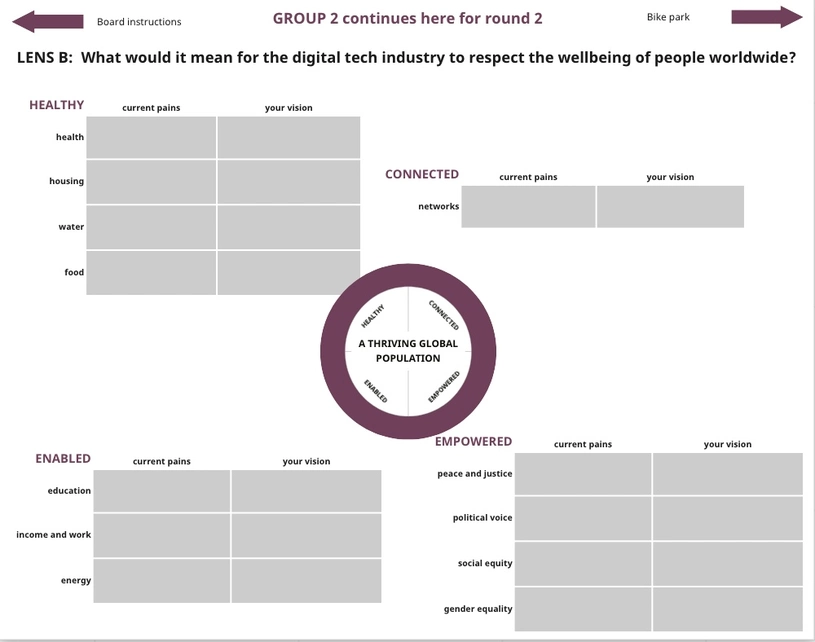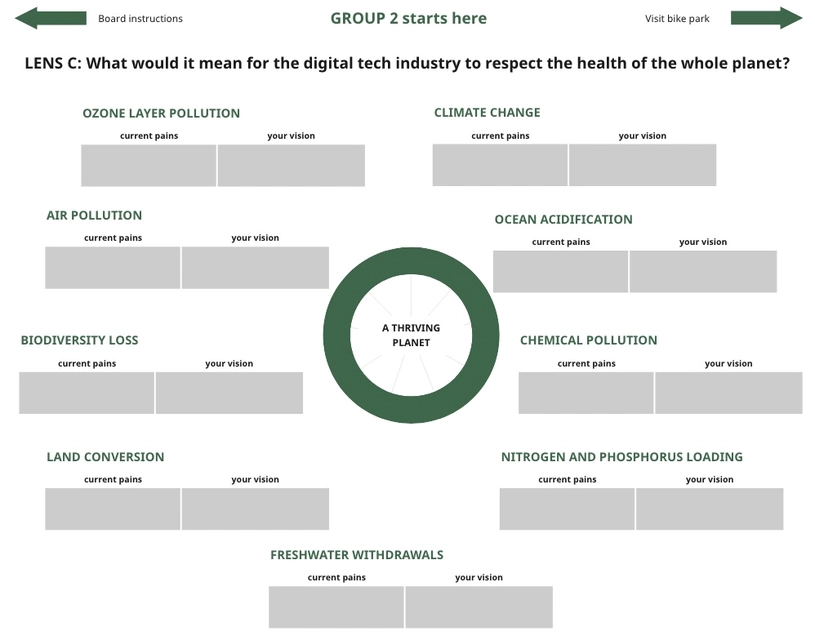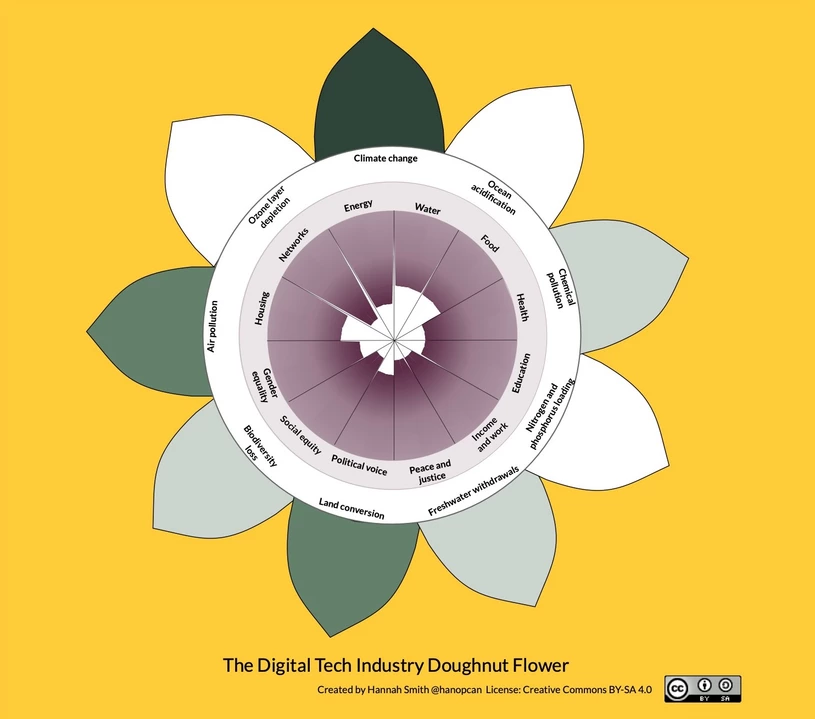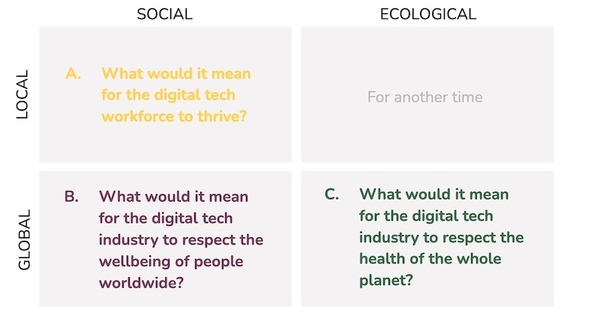
Exploring sustainability in digital tech
Can Doughnut Economics be used as a holistic way of exploring the digital tech sector’s impact on global sustainability?

When sustainability is discussed within the digital tech industry, the conversation often revolves around electricity use. Typically “how can we reduce electrical consumption in data centers or on end-user devices, and how can we decarbonise it?”.
This is great progress, but the industry is in danger of overlooking the big, more difficult questions.
Questions like: what exactly are those paradigms, systems and root causes that have got us into a rapidly warming climate? And how has this industry been culpable? And how does it continue to be culpable? What do we need to change?
DoingtheDoughnut.tech was conceived to support people within the digital tech industry to:
- explore a broad definition of sustainability;
- look deeper into the root causes of what is going wrong;
- imagine a better future for the industry.
Using the excellent Doughnut Economics framework as a vehicle to generate these discussions and understanding with the digital tech sector, we ran three pilot workshops to explore how we move beyond fixating on carbon emissions.
The Creating City Portraits guide provided a whole ton of inspiration on how to start this. But instead of regarding a place, we wanted to think about an industry: the digital tech industry.
Workshop design
We began designing the workshop and came up with three core questions that seemed valuable to explore.
- LOCAL/SOCIAL: What would it mean for the digital tech workforce to thrive?
- GLOBAL/SOCIAL: What would it mean for the digital tech industry to respect the wellbeing of people worldwide?
- GLOBAL/ECOLOGICAL: What would it mean for the digital tech industry to respect the health of the whole planet?
29 people working within the digital tech sector joined three pilot workshops to explore these questions. The workshops were 2.5 hours each and were designed for between 6 and 10 participants, with 2 facilitators.
It started with a round of introductions between the attendees which provided a good chance for people to get to know each other. The main part of the workshop split attendees into two groups and asked them to explore the lenses using a Miro board to facilitate the session. Each of the lenses encouraged attendees to explore the pains they see in each of the dimensions, and ideas or vision for changing that in the future.
LOCAL/SOCIAL: What would it mean for the digital technology workforce to thrive?
GLOBAL/SOCIAL: What would it mean for the digital technology workforce to thrive?
GLOBAL/ECOLOGICAL: What would it mean for the digital tech industry to respect the health of the whole planet?
Our key findings
Did the approach work?
YES! After hosting these workshops, we felt that the Doughnut provides a friendly, accessible – and non-ideological – way of encouraging people to address fundamental and possibly radical concepts of sustainability, for example challenging economic growth, consumption and waste.
Taking action to shift the status-quo
Our workshop attendees were prompted to discuss a vision for the future for each of the 21 dimensions. In this regard, the discussions between the attendees questioned many of the fundamentals of tech industry business models.
These are the four common tech strategies that our attendees highlighted as needing to shift if the digital tech industry is to become more sustainable:
- Stop the relentless consumption/depletion of resources – attention based revenue is driving the wrong behaviours.
- Pointless – and endless – growth is getting us nowhere – the exponential growth bubble needs to burst.
- Build things that last and can be reused – the strategy of planned obsolescence only serves shareholders and not society.
- Detoxify tech culture – replace with fairness, inclusion and better ways of working.
The doughnut flower
The digital tech industry doughnut flower diagram is a visual representation of the conversation amongst our attendees from the pilot workshops. It draws inspiration from the well-known Doughnut Economics approach of quantifying the doughnut.
The outer petals represent the ecological boundaries. The darker the shade of green the more this came up as a pain point during the discussion. The inner stamens represent the social foundations and the longer and darker the stamen the more this issue featured in the workshop discussions.
For more info and insights
We wrote all of our findings and a more detailed methodology onto a website called: DoingTheDoughnut.tech. We hope our work may inspire others!
Share
Share
-
Tool

A City Portrait Canvas for Workshops
A workshop tool to evaluate strategies through the City Portrait’s ‘4 lenses’
-
Tool

A Quick Introduction to the Doughnut
Introducing the Doughnut and its application in Amsterdam
-
Tool

Dimensions of the Doughnut
An introduction to each of the 21 social and ecological dimensions of the Doughnut
-
Tool

Doughnut Economics TED Talk
Kate Raworth's TED Talk from 2018
-
Tool
.png)
Sparking Connections
A set of 37 cards to explore the connections between the dimensions of the Doughnut and the Four Lenses
-
Tool

Four lenses - Four questions of city portrait
Use as a starting point for conversations and engagement in your community, to get people thinking and talking!
-
Tool

Illustrated Doughnut Diagram
A friendly and artistic version of Doughnut diagram
-
Tool

Joining the Doughnut Dots
An activity for getting to know the dimensions of the Doughnut and their interconnections
-
Member

Daniela Borodak
Clermont-Ferrand, France
The doughnut economy is a source of inspiration for my teaching! I hope this community helps me to answer the questions I'm constantly asking myself: How can we train managers who are more embodied and more concerned with ethics? How can we make future managers aware that it is possible to move away from individualism and competition towards the collective interest in the business world?
-
Member


Diego Ibanez
Geneva, Switzerland
I am currently learning low-level programming (C language). In the near future, I would like to work in risk advisory for banks and trading companies as consultant employed by a major audit company. My dream job is to work as CTO in an energy trading company and help with the energy transition. Goal is to reduce dependency to oil and other fossil fuels, there are plenty of ways we can take action without getting mad at each other, that's what I believe.
-
Member


cristina sarris
Athènes, Αττική, Grèce
From Business Transformation Consultant to Sustainability Capacity Building Facilitator for organisations that need to interpret and analyse their environmental impact. I co-founded the "Greece Doughnut Economics" network in 2021. We are a small and dynamic network that has been meeting regularly. My dream is to accomplish the translation of the book into Greek and run workshops using the Doughnut tool in Greek municipalities.
-
Member


Samuel Plumppu
Stockholm, Sweden
Lead Developer and Founding member of https://greenheart.coop
-
Member


Irfan Qalamkar
IT Service Management | Strategy | Digital TX | EdTech | Open Innovation | Smart Cities
-
Member


Karn Bianco
Scotland, United Kingdom
Hello there 👋 I'm the Digital Platform Lead here at DEAL, which means I lead the design, development and management of this website, the DEAL Community Platform. My professional background is in game development as a programmer. I'm interested in using play to help people explore important and complex topics. I'm also a freelance writer covering the games industry, technology and climate change I've been involved in the fossil fuel divestment movement as a campaigner, combining the need for climate action with tangible steps towards a more regenerative economic system. I also helped found the game workers branch of the IWGB - the UK's first trade union dedicated to empowering and improving the rights of workers in the games industry.

